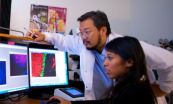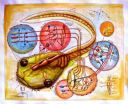(Press-News.org) RIVERSIDE, Calif. – Ripping a page from the Star Trek script, specialized cells of the barrier that lines the inside of the intestines and airways of humans have invoked a biological version of Captain Kirk's famous command "shields up" as a first defense against invading microbes.
Research in the UCR School of Medicine laboratory of David Lo found that certain cells of the epithelium have a potentially important role in immune surveillance – creating an electrostatic repulsion field to microbial invasion.
The study is featured on the cover of the July issue of Infection and Immunity, a journal published by the American Society for Microbiology. Co-authors of the study are Kaila M. Bennett, one of Lo's graduate students, and Sharon L. Walker, a UCR professor of chemical and environmental engineering.
The finding improves scientists' understanding of the densely packed protrusions – resembling a carpet – on the surface of some cells that line the insides of the intestines and respiratory system. The protrusions, which biologists call microvilli, increase the surface area of cells and have a role in absorbing nutrients, for instance.
But Lo's laboratory has found that the microvilli actually repel negatively charged bacteria and viruses, suggesting a protective "shield" akin to the force field that envelops the Enterprise in the plots of many "Star Trek" television episodes and movies.
"This is a whole new way of looking at immune surveillance in the epithelium of the human gut and airway," said Lo, a distinguished professor in the medical school's Division of Biomedical Sciences. "If we can take advantage of this electrostatic repulsion, it could improve the diagnosis and treatment of certain bacterial infections."
A number of bacterial and viral infections can gain a foothold in the human body through adsorption via the intestines and airways, such as Salmonella and the flu.
Lo's laboratory has for more than a dozen years studied immune responses in the gut and airways, focusing particularly on cells which function as an early warning in the immune system. "We study the role of certain epithelial cells in the immune system. By understanding how the immune system is able to capture and carry viruses and bacteria across this barrier to trigger a protective immune, we may be able to design better synthetic vaccines, including needle-free vaccines," Lo said.
Lo joined UCR in 2006. In addition to his faculty position in the UCR School of Medicine Division of Biomedical Sciences, he is affiliated with the UCR Center for Disease Vector Research and the UC Global Health Institute. He is a fellow of the American Association for the Advancement of Sciences (2007) and a 2005 recipient of a "Grand Challenges in Global Health" award, Bill and Melinda Gates Foundation and the Foundation for the National Institutes of Health.
INFORMATION:
The University of California, Riverside is a doctoral research university, a living laboratory for groundbreaking exploration of issues critical to Inland Southern California, the state and communities around the world. Reflecting California's diverse culture, UCR's enrollment has exceeded 21,000 students. The campus opened a medical school in 2013 and has reached the heart of the Coachella Valley by way of the UCR Palm Desert Center. The campus has an annual statewide economic impact of more than $1 billion. A broadcast studio with fiber cable to the AT&T Hollywood hub is available for live or taped interviews. UCR also has ISDN for radio interviews. To learn more, call (951) UCR-NEWS.
Study reveals protective role for specialized cells in intestinal and respiratory systems
UC Riverside discovery of electrostatic force field could inform future development of needle-free vaccines
2014-07-07
ELSE PRESS RELEASES FROM THIS DATE:
Expectant moms turn to 'Dr. Google' for pregnancy advice
2014-07-07
Pregnant women are using the Internet to seek answers to their medical questions more often than they would like, say Penn State researchers.
"We found that first-time moms were upset that their first prenatal visit did not occur until eight weeks into pregnancy," said Jennifer L. Kraschnewski, assistant professor of medicine and public health sciences, Penn State College of Medicine. "These women reported using Google and other search engines because they had a lot of questions at the beginning of pregnancy, before their first doctor's appointment."
Following the women's ...
Summer McJobs are good for kids, says UBC study
2014-07-07
A new UBC Sauder School of Business study shows that teenagers who work at summer or evening jobs gain a competitive advantage later in life. Developing early knowledge of the working world and how to manage in it, they are more likely to find good employment and earn more money in the future.
"With summer in full swing and kids sitting on the couch, parents are wondering whether to push them to find a job," says Sauder professor Marc-David L. Seidel, who co-authored the study. "Parents may think that their kids could do better than a job at the local fast food joint. ...
For a holistic approach to POW trauma
2014-07-07
The full circumstances of U.S. soldier Bowe Bergdahl's captivity have yet to be revealed. During his tour of duty in Afghanistan in 2009, Bergdahl was captured by the Taliban and held in captivity for five years until a controversial prisoner exchange led to his release on May 31. Bergdahl has been accused of deserting his post and advocating the release of Afghani prisoners.
"We do know that he suffered horrific conditions, tortured and kept in a metal cage in darkness for weeks on end," said Prof. Zahava Solomon, an Israel Prize laureate, Professor of Social Work and ...
Patient patience and pandemics
2014-07-07
Allowing patients to choose which hospital they attend when suffering illness during a pandemic rather than assigning them to a specific healthcare facility is appealing to patients during such a crisis. However, such a patient-centric hospital capacity management is conventionally viewed as inefficient system-wide. According to research published in the International Journal of Mathematics in Operational Research, an incentive-based approach for hospital capacity management can not only accomplish a high efficiency for a concerned hospital system but satisfy patients' ...
World Cup chemistry: The science behind the 'brazuca' (video)
2014-07-07
WASHINGTON, July 7, 2014 — The World Cup final is almost here, and no matter which two teams meet for the title match, there's one thing they'll both need to win: the ball. This week, Reactions examines the chemistry that goes into making the "brazuca," and what makes it different from most other soccer balls out there. The video is available at https://www.youtube.com/watch?v=1XNTfslUzt8.
INFORMATION:
Subscribe to the series at Reactions YouTube, and follow us on Twitter @ACSreactions to be the first to see our latest videos.
The American Chemical Society is a nonprofit ...
Infant toenails reveal in utero exposure to low-level arsenic, Dartmouth study finds
2014-07-07
Infant toenails are a reliable way to estimate arsenic exposure before birth, a Dartmouth College study shows.
The findings appear in the Journal of Exposure Science & Environmental Epidemiology. A PDF of the study is available on request.
A growing body of evidence suggests that in utero and early-life exposure to arsenic may have detrimental effects on children, even at the low to moderate levels common in the United States and elsewhere. The fetus starts to develop toenails during the first trimester, making them an accurate measure of exposure to arsenic during ...
GVSU researchers find moral beliefs barrier to HPV vaccine
2014-07-07
GRAND RAPIDS, Mich. — A survey of first-year Grand Valley State University students showed the biggest barrier to receiving a Human Papillomavirus (HPV) vaccine was moral or religious beliefs, or a perceived promotion of sexual behavior, according to graduate physician assistant researchers.
Physician Assistant Studies majors Jamie Phillipich and Margie Webb surveyed 1,000 incoming students last fall as part of their master's research project. They assessed the influence media has on the perception of HPV and vaccine compliance, and presented their findings at the Annual ...
Dodging dots helps explain brain circuitry
2014-07-07
PROVIDENCE, R.I. [Brown University] — A neuroscience study provides new insight into the primal brain circuits involved in collision avoidance, and perhaps a more general model of how neurons can participate in networks to process information and act on it.
In the study, Brown University neuroscientists tracked the cell-by-cell progress of neural signals from the eyes through the brains of tadpoles as they saw and reacted to stimuli including an apparently approaching black circle. In so doing, the researchers were able to gain a novel understanding of how individual ...
Satellites reveal possible catastrophic flooding months in advance, UCI finds
2014-07-07
Irvine, Calif., July 7, 2014 – Data from NASA satellites can greatly improve predictions of how likely a river basin is to overflow months before it does, according to new findings by UC Irvine. The use of such data, which capture a much fuller picture of how water is accumulating, could result in earlier flood warnings, potentially saving lives and property.
The research was published online Sunday in the journal Nature Geoscience.
A case study of the catastrophic 2011 Missouri River floods showed that factoring into hydrologic models the total water storage information ...
Why 'whispers' among bees sometimes evolve into 'shouts'
2014-07-07
Let's say you're a bee and you've spotted a new and particularly lucrative source of nectar and pollen. What's the best way to communicate the location of this prize cache of food to the rest of your nestmates without revealing it to competitors, or "eavesdropping" spies, outside of the colony?
Many animals are thought to deter eavesdroppers by making their signals revealing the location or quality of resources less conspicuous to outsiders. In essence, they've evolved "whispers" in their signals to counter eavesdropping.
But some species of bees in Brazil do the exact ...
LAST 30 PRESS RELEASES:
University of Oklahoma researcher awarded funding to pursue AI-powered material design
Exploring how the visual system recovers following injury
Support for parents with infants at pediatric check-ups leads to better reading and math skills in elementary school
Kids’ behavioral health is a growing share of family health costs
Day & night: Cancer disrupts the brain’s natural rhythm
COVID-19 vaccination significantly reduces risk to pregnant women and baby
The role of vaccination in maternal and perinatal outcomes associated with COVID-19 in pregnancy
Mayo Clinic smartwatch system helps parents shorten and defuse children's severe tantrums early
Behavioral health spending spikes to 40% of all children’s health expenditures, nearly doubling in a decade
Digital cognitive behavioral treatment for generalized anxiety disorder
Expenditures for pediatric behavioral health care over time and estimated family financial burden
Air conditioning in nursing homes and mortality during extreme heat
The Alps to lose a record number of glaciers in the next decade
What makes a good proton conductor?
New science reporting guide published for journalists in Bulgaria
New international study reveals major survival gaps among children with cancer
New science reporting guide published for journalists in Turkey
Scientists develop a smarter mRNA therapy that knows which cells to target
Neuroanatomy-informed brain–machine hybrid intelligence for robust acoustic target detection
Eight SwRI hydrogen projects funded by ENERGYWERX
The Lundquist Institute and its start-up company Vitalex Biosciences Announces Strategic Advancement of Second-Generation fungal Vaccine VXV-01 through Phase 1 Trials under $40 Million Competitive Con
Fine particles in pollution are associated with early signs of autoimmune disease
Review article | Towards a Global Ground-Based Earth Observatory (GGBEO): Leveraging existing systems and networks
Penn and UMich create world’s smallest programmable, autonomous robots
Cleveland researchers launch first major study to address ‘hidden performance killer’ in athletes
To connect across politics, try saying what you oppose
Modulating key interaction prevents virus from entering cells
Project explores barriers to NHS career progression facing international medical graduates
Jeonbuk National University researchers explore the impact of different seasonings on the flavor perception of Doenjang soup
Two Keck Medicine of USC Hospitals named Leapfrog Top Teaching Hospitals
[Press-News.org] Study reveals protective role for specialized cells in intestinal and respiratory systemsUC Riverside discovery of electrostatic force field could inform future development of needle-free vaccines


